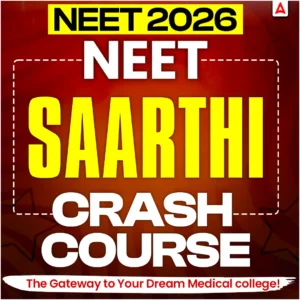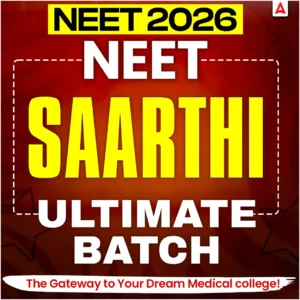Body Fluids and Circulation NEET Notes: Did you know that your heart pumps approximately 5 liters of blood every minute to keep your health intact? This demonstrates Body Fluids and Circulation, one of the most significant chapters in NEET Biology. The topic of this chapter will cover the composition of blood and lymph, the working of the heart, the cardiac cycle, and the mechanism of double circulation.
Body Fluids and Circulation are important for developing your core concepts and also earning you those valuable marks in your exams. In this article, we will provide structured NEET notes that contain simple explanations, flowcharts, and important points. The notes will help you to revise Body Fluids and Circulation quickly, and help you prepare more easily, faster, and with more effective preparation for the upcoming NEET exam.
Body Fluids in Humans: NEET Notes
The human body has two major fluids – blood and lymph. Blood is a specialized connective tissue consisting of plasma and formed elements. Plasma transports nutrients, hormones, and waste products, red blood cells transport oxygen, white blood cells combat infection, and platelets are used to clot blood. Lymph, on the other hand, is a colorless fluid that is involved in connecting blood with tissues for fluid balance and fusion, and to protect the body from disease because it is involved in immunity. Together, blood and lymph ensure the distribution of vital substances as well as the defense against diseases. There are two main body fluids in our system:
1. Blood
- A specialized connective tissue.
- Composed of plasma (55%) and formed elements (45%).
- Plasma: 90–92% water, 6–8% proteins (albumin, globulin, fibrinogen), ions, nutrients, hormones, and wastes.
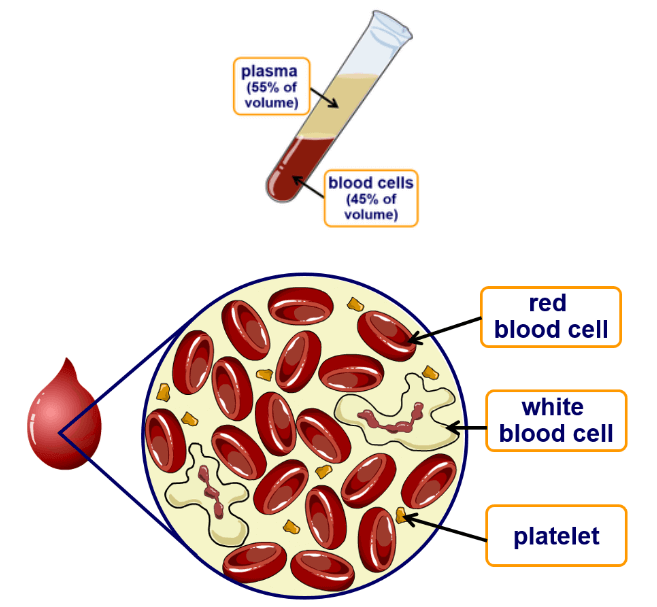
The blood is composed of many different Elements:
RBCs (Erythrocytes):
Red Blood Cells, also called erythrocytes, are the most abundant blood cells. They contain hemoglobin, which carries oxygen from the lungs to body tissues and transports carbon dioxide back to the lungs. Mature RBCs are biconcave, enucleated, and live about 120 days. Their primary role is oxygen transport.
WBCs (Leukocytes):
White Blood Cells, or leukocytes, form the body’s defense army. They protect against infections by destroying bacteria, viruses, and harmful agents. WBCs are of two types: granulocytes (neutrophils, eosinophils, basophils) and agranulocytes (lymphocytes, monocytes). Unlike RBCs, they are nucleated. Their number increases rapidly during infections.
Platelets (Thrombocytes):
Platelets are small, disc-shaped, non-nucleated cell fragments formed from bone marrow. Their main function is in blood clotting and preventing excessive blood loss after injury. When a blood vessel is damaged, platelets release factors that help form clots. They survive for 7–10 days and circulate in large numbers.
Plasma:
Plasma is the liquid part of blood, making up about 55% of total blood volume. It is 90–92% water and contains proteins (albumin, globulin, fibrinogen), nutrients, hormones, and waste products. Plasma transports these substances throughout the body and also helps in maintaining blood pressure, pH balance, and immunity.
2. Lymph (Tissue Fluid)
- Lymph is a colorless fluid without RBCs.
- Transports nutrients, hormones, and fights infections.
- Maintains fluid balance and acts as a link between the blood and tissues.
Circulation in Humans: NEET Notes
Circulation is the continual movement of blood through the heart, blood vessels, and body tissues. Humans possess a system of double circulation, which means that blood moves through the heart twice in one complete cycle. The right side of the heart pumps deoxygenated blood to the lungs (pulmonary circulation), and the left side pumps oxygenated blood to all the body organs (systemic circulation). Double circulation means that oxygen can always be provided to the tissues, nutrients can be constantly supplied throughout the body, and waste can be removed. All of this activity is needed to keep the body functioning and alive.
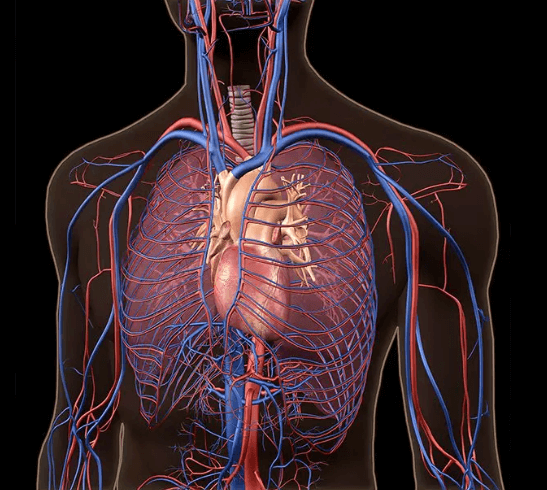
Types of Circulatory System
- Pulmonary Circulation: Right ventricle → Lungs → Left atrium (oxygenation of blood).
- Systemic Circulation: Left ventricle → Body organs → Right atrium (supply of oxygen and nutrients).
Parts of the Circulatory System
The human circulatory system is double and closed, meaning blood flows through vessels and passes through the heart twice in one complete cycle. The Human Circulatory system consists of many different parts:
1. Heart
The heart is an important organ in our body, about the size of a fist and located in the chest. The primary function of the heart is to pump blood throughout the body. The blood carries oxygen and nutrients that are used by the organs to function. The heart has four chambers, two atria and two ventricles. The heart works constantly and beats, on average, about seventy beats per minute to keep blood flowing. It is important to maintain a healthy heart; this could include eating a healthy diet, getting regular exercise, and limiting stress in your life. A healthy heart allows us to remain strong and active.
Structure of the Heart
- Valves (tricuspid and bicuspid) ensure unidirectional flow.
- A Human Heart is a muscular organ that has four compartments known as “Chambers” inside it, which are named the Right atrium, Left atrium, Right ventricle, and left ventricle.
| Chambers of Heart | Description |
| Left Atrium | Receives oxygenated blood from the lungs via the pulmonary veins. |
| Left Ventricle | Pumps oxygenated blood to the rest of the body through the aorta. |
| Right Atrium | Receives deoxygenated blood from the body through the superior and inferior vena cava. |
| Right Ventricle | Pumps deoxygenated blood to the lungs for oxygenation through pulmonary arteries. |
2. Blood Vessels
Blood vessels are tube-like structures that carry blood throughout the body. They form a vast network called the circulatory system, which connects the heart to every part of the body. There are three main types of blood vessels:
Arteries –
- Carry blood away from the heart.
- Transport oxygen-rich blood (except pulmonary artery).
- Have thick, elastic walls to handle high pressure.
Veins –
- Carry blood towards the heart.
- Transport oxygen-poor blood (except pulmonary vein).
- Have thin walls and valves to prevent backflow of blood.
Capillaries –
- Very tiny vessels connecting arteries and veins.
- Exchange of gases, nutrients, and wastes happens here.
Cardiac Cycle
The cardiac cycle is the sequence of events that occurs in one complete heartbeat. At a normal heart rate of 72 beats per minute, each cycle lasts about 0.8 seconds. It includes contraction (systole) and relaxation (diastole) of atria and ventricles, ensuring continuous blood flow.
1. Atrial Systole (0.1 sec)
- The atria contract, pushing blood into the ventricles.
- The tricuspid and bicuspid valves (AV valves) are open.
- Semilunar valves (pulmonary and aortic) remain closed.
- About 30% of ventricular filling happens here (the rest occurs passively before).
2. Ventricular Systole (0.3 sec)
- The ventricular Sistole has two phases:
- Isovolumetric Contraction (0.05 sec): Ventricles contract, pressure rises.
AV valves close → produces the first heart sound “Lub.”
Semilunar valves still closed.
- Ventricular Ejection (0.25 sec): Pressure forces semilunar valves to open.
Blood is pumped into the aorta and pulmonary artery.
Stroke Volume = 70 mL per beat.
3. Joint Diastole (0.4 sec)
- Both atria and ventricles relax.
- Ventricular pressure falls, semilunar valves close → second heart sound “Dub.”
- AV valves open, and blood flows passively from atria to ventricles.
- This is the longest phase, allowing maximum filling of the ventricles.
Key Points for NEET that Students Must Keep in Mind
- Human heart rate = 72/min → 0.8 sec per cycle.
- Cardiac Output = Stroke Volume × Heart Rate = 70 × 72 = ~5 L/min.
- Heart sounds: Lub (S1) = closure of AV valves, Dub (S2) = closure of semilunar valves.
Regulation of Cardiac Activity
The human heart is myogenic, meaning it generates its own impulses for contraction. However, its activity is finely regulated by nervous and hormonal control systems to match the body’s needs. Thus, cardiac regulation ensures the heart works faster during high demand (exercise, stress) and slower during rest, maintaining balance.
Pacemaker Control
- The Sinoatrial Node (SA Node), present in the right atrium, acts as the natural pacemaker of the heart.
- It generates rhythmic impulses that set the pace of heartbeat.
- The Atrioventricular Node (AV Node) relays these impulses to the ventricles through the Bundle of His and Purkinje fibers, ensuring coordinated contraction.
Nervous Control
- Sympathetic Nervous System: Increases heart rate and force of contraction (e.g., during exercise, stress).
- Parasympathetic Nervous System (via Vagus Nerve): Slows down the heart rate, conserving energy (e.g., during rest).
Hormonal Control
Adrenaline and Noradrenaline secreted by the adrenal glands during stress/excitement increase heart rate and pumping efficiency.
Disorders of the Circulatory System
The circulatory system is vital for life, and any disturbance can lead to serious health problems. Understanding these disorders is important for NEET as questions often focus on causes, symptoms, and preventive measures. Some important disorders include:
Hypertension (High Blood Pressure)
- Persistent increase in blood pressure (above 140/90 mmHg).
- Damages blood vessels and increases risk of stroke, kidney failure, and heart attack.
Coronary Artery Disease (CAD)
- Caused by atherosclerosis (fatty deposits) in the coronary arteries.
- Reduces blood flow to the heart muscles, leading to chest pain.
Angina Pectoris
- Severe chest pain due to a temporary lack of oxygen supply to the heart.
- Often triggered by stress or exertion.
Heart Failure (Congestive Heart Failure)
- The heart cannot pump blood effectively to meet the body’s needs.
- Leads to fatigue, breathlessness, and fluid accumulation.
Stroke (Cerebrovascular Accident)
- Caused by blockage or rupture of blood vessels in the brain.
- Results in paralysis, loss of speech, or even death.
Why are Body Fluids and Circulation NEET Notes Important?
- High-Weightage Chapter – This topic carries significant weight in NEET, with direct questions asked every year.
- Foundation for Human Physiology – Understanding circulation is the basis for grasping respiration, excretion, and other physiological systems.
- Concept Clarity – Notes simplify complex processes like the cardiac cycle, double circulation, and ECG, making them easier to revise.
- Diagram-Based Questions – Heart structure, blood vessels, and circulation diagrams are frequently tested in NEET.
- Link with Disorders – Knowledge of hypertension, anemia, heart diseases, and clotting helps in both NEET Biology and future medical studies.
- Quick Revision Tool – Notes allow aspirants to revise in less time before exams without going through bulky textbooks.
- Application in Clinical Questions – NEET often asks applied/analytical questions (e.g., effect of blocked artery, changes in blood pressure).
- Boosts Accuracy – Clear notes reduce confusion between similar terms (like arteries vs veins, systole vs diastole).
- NCERT Coverage – Concise notes ensure nothing is missed from the NCERT, which is the primary source for NEET.









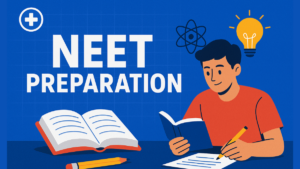 NEET Preparation Strategy 2026: Detailed...
NEET Preparation Strategy 2026: Detailed...
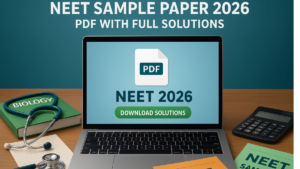 Free NEET Sample Papers 2026 PDF | Downl...
Free NEET Sample Papers 2026 PDF | Downl...
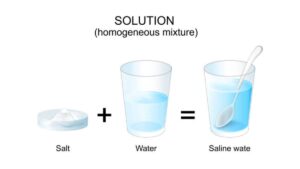 Salt Analysis NEET Notes, Check Importan...
Salt Analysis NEET Notes, Check Importan...
